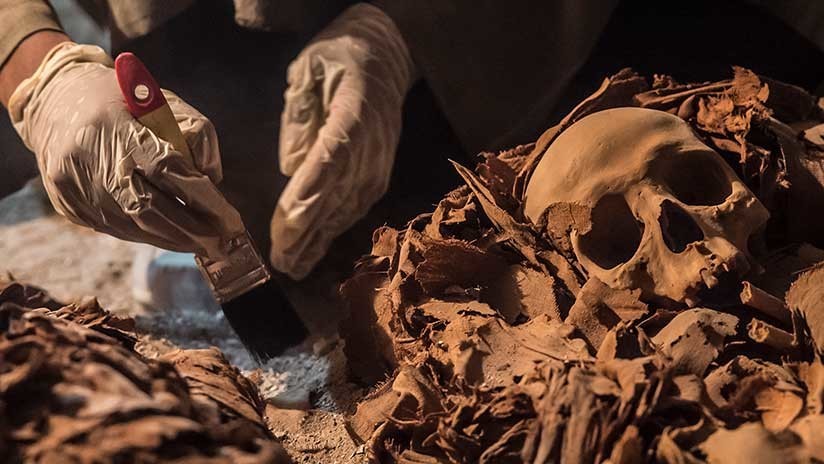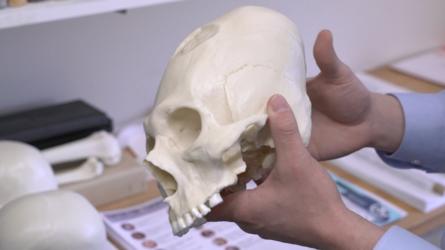 ImageLa forma alargada y estrecha de la cabeza fue un rasgo distintivo de lo collaguas, pero con el tiempo se extendió a todo el valle del Colca. (Foto: Dan Chamberlain/Universidad Cornell)
ImageLa forma alargada y estrecha de la cabeza fue un rasgo distintivo de lo collaguas, pero con el tiempo se extendió a todo el valle del Colca. (Foto: Dan Chamberlain/Universidad Cornell)
Hubo un tiempo en que nacer en la tierras altas o bajas del valle del Colca, en lo que hoy es el departamento de Arequipa, al sur de Perú, determinaba la forma de la cabeza de los bebés.
Entre los años 1100 y 1450, las familias de los dos grupos étnicos predominantes en esta región andina, los collaguas y cabanas, modificaban el cráneo de los recién nacidos usando vendajes con telas y hasta maderas.
Pero lejos de ser una simple cuestión estética, esta práctica tuvo consecuencias sociales y políticas a tal punto que podría haber cambiado el vínculo de estas antiguas civilizaciones con el imperio inca que llegaría a dominar la región.
"Antes de mi estudio contábamos mayormente con los reportes de los españoles de la época colonial", le dijo a BBC Mundo el antropólogo estadounidense Matthew Velasco, docente e investigador de la Universidad Cornell de Estados Unidos.
Su trabajo, publicado este mes en la revista científicaCurrent Anthropology, develó que lo que se creía era un marcador étnico exclusivo de los collaguas fue en verdad "una práctica mucho más dinámica, que se transformó a través del tiempo", explicó Velasco.
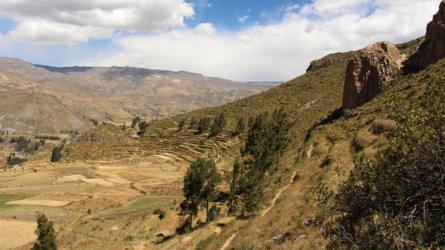 ImageLos collaguas y los cabanas vivían en las tierras altas y bajas del valle respectivamente. (Foto: David Rodríguez Sotomayor/Proyecto Bioarqueológico Coporaque)
ImageLos collaguas y los cabanas vivían en las tierras altas y bajas del valle respectivamente. (Foto: David Rodríguez Sotomayor/Proyecto Bioarqueológico Coporaque)
Porque lo que en un principio servía para distinguir a los collaguas de los cabanas, terminó uniéndolos contra los invasores incas.
De dos formas
Los collaguas vivían en la zona alta del valle del Colca, hablaban aymara y se especializaban en la crianza de alpacas para extraerles la lana.
Según documentos coloniales de la época, los collaguas vendaban los maleables cráneos de los bebés para darlesuna forma alargada y estrecha.
El objetivo, detallaban los cronistas españoles, era que las cabezas tuvieran una forma similar al volcán Collaguata, considerado el lugar de origen mítico de esta etnia.
Los cabanas, en cambio, hablaban quechua y cultivaban maíz en las fértiles tierras de la zona baja del valle.
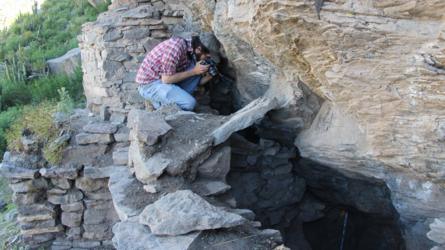 ImageMatthew Velasco investigó el tema con el apoyo de la comunidad de Coporaque, descendientes de los antiguos collaguas. (Foto: David Rodríguez Sotomayor/Proyecto Bioarqueológico Coporaque)
ImageMatthew Velasco investigó el tema con el apoyo de la comunidad de Coporaque, descendientes de los antiguos collaguas. (Foto: David Rodríguez Sotomayor/Proyecto Bioarqueológico Coporaque)
Estos daban a los cráneos de los infantes una forma más achatada y amplia presionando el lado posterior de la cabeza. "Probablemente usaban placas de madera (es decir, materiales más duros) para conseguir esta forma", detalló Velasco.
Al analizar cientos de restos óseos humanos de múltiples tumbas en el valle del Colca, Velasco descubrió que antes del 1300 la mayoría de las personas no presentaban modificaciones en las cabezas.
La práctica, observada en solo 39,2% de los cráneos, pasó a representar el 73,7% luego de dicha fecha.
Pero esto no es todo: con el paso del tiempo, la forma cónica comenzó a predominar.
Esta creciente homogeneidad en las formas de cabezas contribuyó a la creación de una nueva identidad colectiva "que pudo haber reforzado los lazos sociales entre élitesdurante un tiempo de mucha guerra y fragmentación social", dijo Velasco.
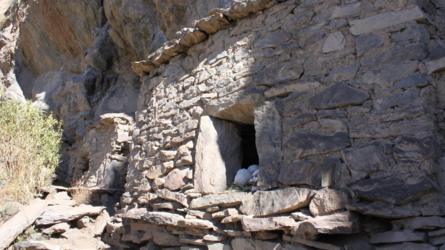 ImageEl estudio publicado en Current Anthropology implicó analizar cientos de restos óseos humanos de múltiples tumbas en el valle del Colca. (Foto: Matthew C. Velasco/Proyecto Bioarqueológico Coporaque)
ImageEl estudio publicado en Current Anthropology implicó analizar cientos de restos óseos humanos de múltiples tumbas en el valle del Colca. (Foto: Matthew C. Velasco/Proyecto Bioarqueológico Coporaque)
Si bien el estudio de Velasco se enfoca en lo sucedido en la región previo al 1450, es decir, antes de la época del imperio inca, el investigador cree que "la formación de una identidad más integradora también pudo haber servido de respaldo a las élites collaguas en sus interacciones con los incas", explicó a BBC Mundo.
"Hay muchas evidencias de que los incas y collaguas llegaron a un acuerdo, que implicó el respeto a las prácticas e instituciones tradicionales de los últimos por parte de los primeros y, al mismo tiempo, estos impusieron formas de tributo", agregó.
Velasco reconoció que "quizás la formación de una identidad compartida y fuerte ayudó a las élites de los collaguas a llegar a un acuerdo más beneficioso con los incas", pero que para probar esta hipótesis se necesitan más datos arqueológicos del valle del Colca en la época del imperio inca.


